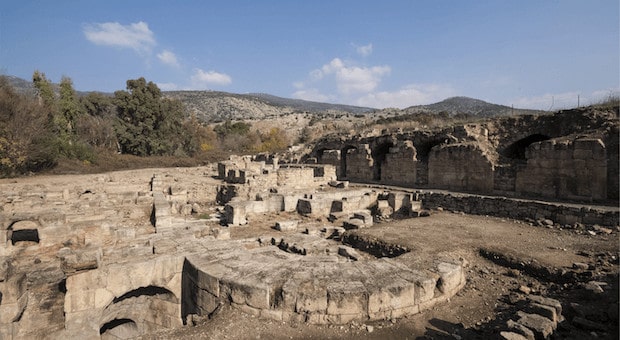But who do you say the Son of Man is? (Matthew 16:15)
Perhaps Jesus’ most famous, pointed question, this marks a turning point in the Gospel of Matthew and is mentioned in Mark and Luke too.
After Simon Peter answers, “You are the Christ, the Son of the living God” (Matthew 16:16; cf Mark 8:29 and Luke 9:20), Jesus replies:
Blessed are you, Simon Bar-Jonah! For flesh and blood has not revealed this to you, but my Father who is in heaven. And I tell you, you are Peter and on this rock I will build my church, and the gates of hell (Hades in the NIV) shall not prevail against it. (Matthew 16:17–18, emphasis mine)
There’s a centuries-old debate about what Jesus meant by the phrase “on this rock I will build my church.”
But to truly understand his response, you have to see how it was deeply entrenched in the geography of Caesarea Philippi, where this scene takes place.
A city of gods
Caesarea Philippi was located at the southern foot of Mount Hermon at the headwaters of the Jordan River, within what is now known as the Golan Heights.
The area is stunning, with flowing streams, waterfalls, trees, and colorful vegetation.
Though beautiful, less honorable activities tarnished the land in ancient biblical times.
It was best known for a massive rock over 100 feet high and 500 feet wide, on which was built the ancient city of Paneas (renamed Caesarea Philippi).
Paneas was a city dominated by immoral activities and pagan worship. In Hellenistic times, it was the religious center for worship of the Greek god Pan, a goat-footed god of shepherds, flocks, and nature. Pan was also known as a universal deity (appropriate for the name “Pan,” which means “all” in Greek).1
Pan’s temple was the largest in the city. Here people cut niches into the cliff of the rock to put statues of Pan and his nymph entourage.
And they committed deplorable acts as worship to these false gods.
Pan’s temple was a first-century red-light district.

Later, Rome conquered the territory from Greek rulers, and Herod Philip rebuilt the city renaming Caesarea Philippi after himself. Sadly, pagan worship continued there—well into the third century AD.
But idolatry isn’t Caesarea’s only dark claim to fame.
Death and demonic activity
Pan’s temple was built in front of a massive cave with a deep spring that could never be measured.
Of this cave Josephus writes:
The place is called Panium, where is a top of a mountain that is raised to an immense height, and at its side, beneath, or at its bottom, a dark cave opens itself; within which there is a horrible precipice, that descends abruptly to a vast depth; it contains a mighty quantity of water, which is immovable; and when anybody lets down anything to measure the depth of the earth beneath the water, no length of cord is sufficient to reach it.”2
To the pagan mind, the cave led straight to the underworld, where fertility gods lived.
People came from far and wide to worship Pan by throwing animal sacrifices into the water in this cave. If the animal vanished, the sacrifice was accepted. If blood surfaced in the spring, it was rejected.
The cave was known throughout the region as the “gates of hell.”
The gates of hell shall not prevail
It was from here Jesus told his disciples he would build his Church “on this rock”:
And I tell you, you are Peter (petros), and on this rock (petra) I will build my church, and the gates of hell shall not prevail against it. (Matthew 16:18, emphasis mine)3
Some traditions believe Jesus’ reference to “this rock” is Peter himself.4
Others affirm Peter’s confession “You are the Christ” in 16:17 as the “rock” and the foundation of the Church.5
But as Jesus was standing with his disciples near this area in Caesarea Philippi, his use of the metaphor “rock” would have been vivid for his disciples, as would “gates of hell” (cf Matt 7:24–25).
It’s possible “this rock” Jesus spoke of alluded to the place they were standing at the time:
In light of the massive rock scarp against which Caesarea Philippi was built and into which were hewn images of dead gods and goddesses, Jesus may have been using petra to refer to the worldviews represented in that rock face. They appeared to be insurmountable but, here, Jesus was declared to be the Living God. In other words, this encounter represented a stinging condemnation of all forms of pagan worship.6
Caesarea Philippi was built on a rock where people’s lives revolved around false gods, death, and demonic activity.
Jesus was announcing a new way of life, and he was using geography to do it.
Instead of idol worship, the church—“a pillar and buttress of the truth” (1 Tim 3:15). Instead of false gods in hell, a living Father in heaven (Rom 9:26; 2 Cor 6:16). Instead of a spring that swallowed life, Living Water that swallows death and creates springs welling up to eternal life (John 4:14).
What better place for Christ to announce his Church.
And nothing will prevail against it.
***
Understanding the geography of Israel enhances our understanding of the narrative of the Bible.
For more information on the geographical, cultural, and historical settings in the Bible, I recommend The Archaeological Encyclopedia of the Holy Land and the award-winning Lexham Geographic Commentary on the Gospels.
Related articles
- What Did Jesus Mean by “Gates of Hell”?
- What Biblical Archaeology and Geography Teach Us
- 3 Reasons to Study the Biblical Geography of Israel
Related resources
- Archaeology, Geography, and Jesus’ Ancient World: Book & Course Bundle (2 vols.; 2 courses) by Craig A. Evans
- Encountering the Holy Land: A Video Introduction to the History and Geography of the Bible by Carl Rasmussen
- The Harvest Handbook of Bible Lands: A Panoramic Survey of the History, Geography, and Culture of the Scriptures by Joseph Holden and Steven Collins
- Collins, John J., and Daniel C. Harlow. Eerdmans Dictionary of Early Judaism, “Paneion (Banias) at the Foot of Mt. Hermon.” Eerdmans Publishing Company, 2010.
- Josephus, Flavius. Wars of the Jews 1.403–405, The Works of Josephus, Updated Edition, Hendrickson Publishers, Inc., 1987.
- Other translations say “gates of Hades.”
- Bruner, Frederick Dale. Matthew: A Commentary, Volume 2. “Confessing Jesus as the Divine Christ by Faithlife Teaching,” Eerdmans Publishing Company, 1990.
- Ibid.
- Beitzel, Barry. Lexham Geographic Commentary on the Gospels, “Peter’s Declaration at Caesarea Philippi,” Lexham Press, Bellingham WA, 2016.








